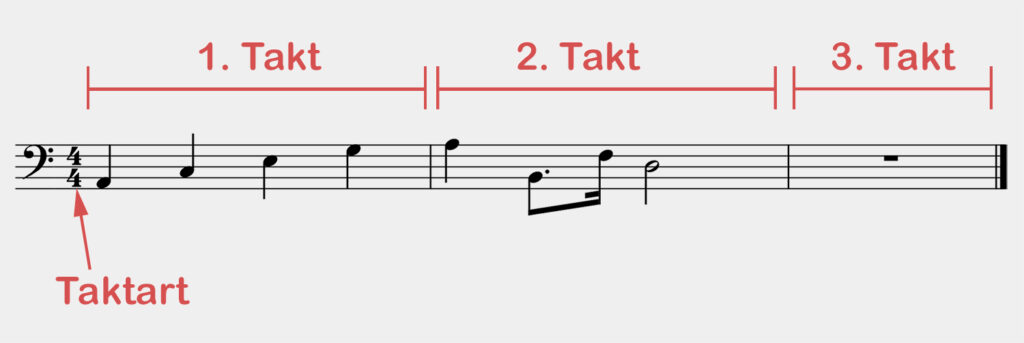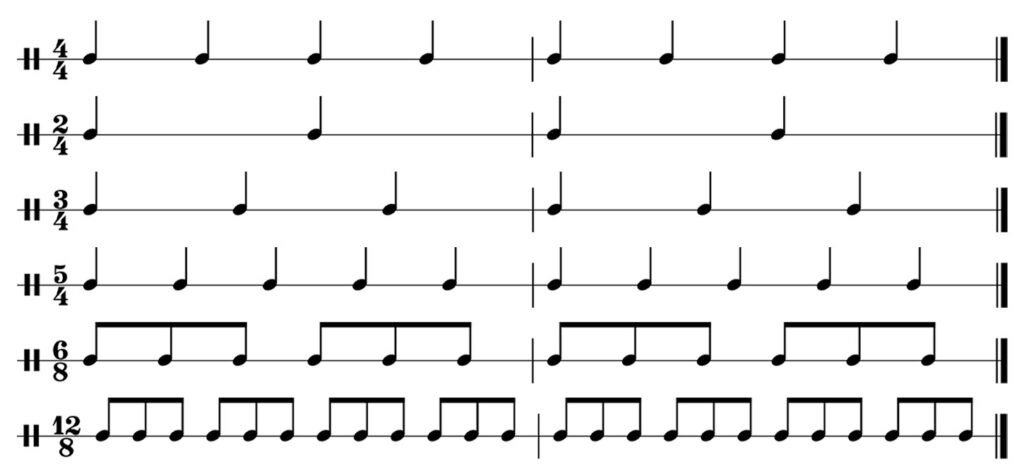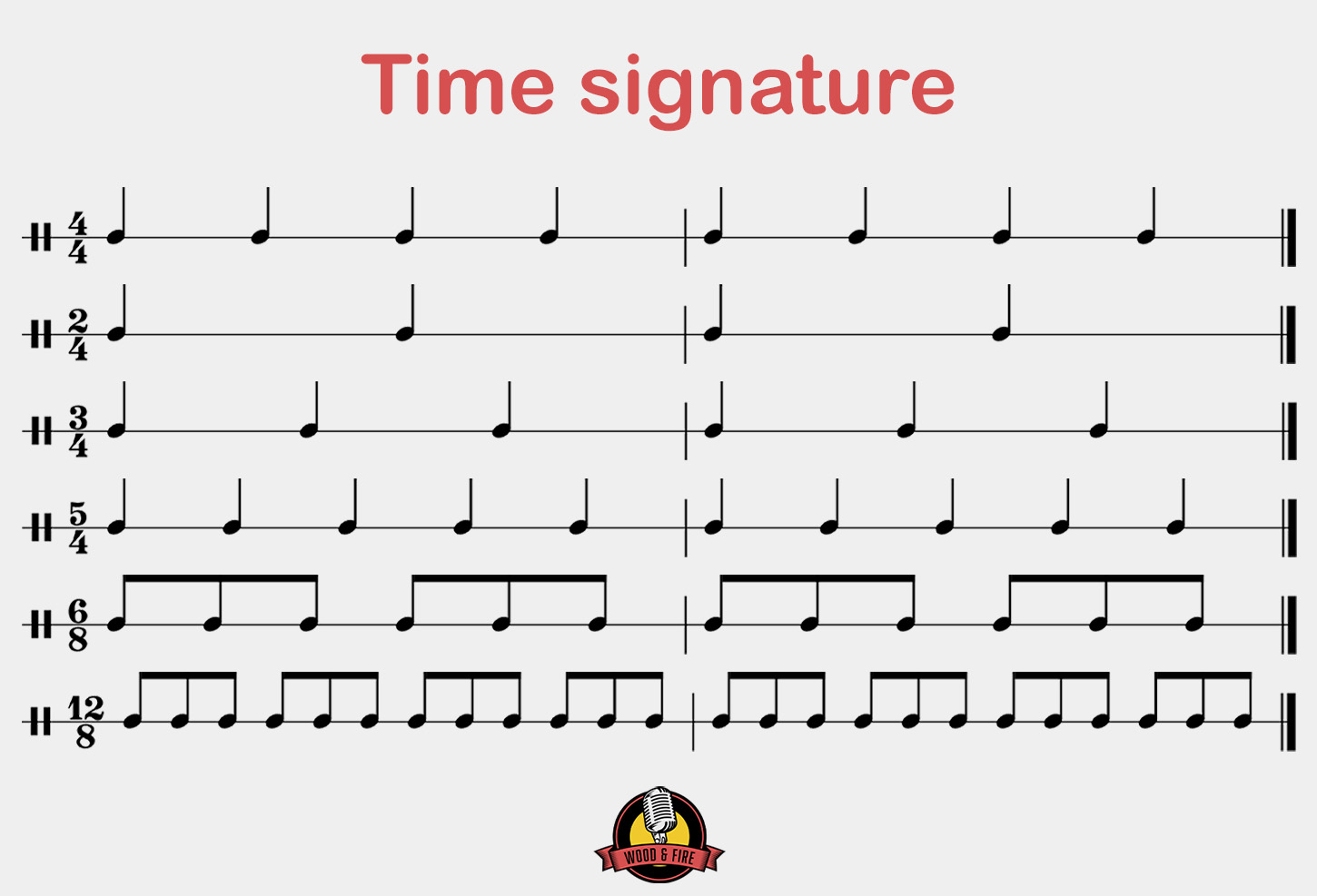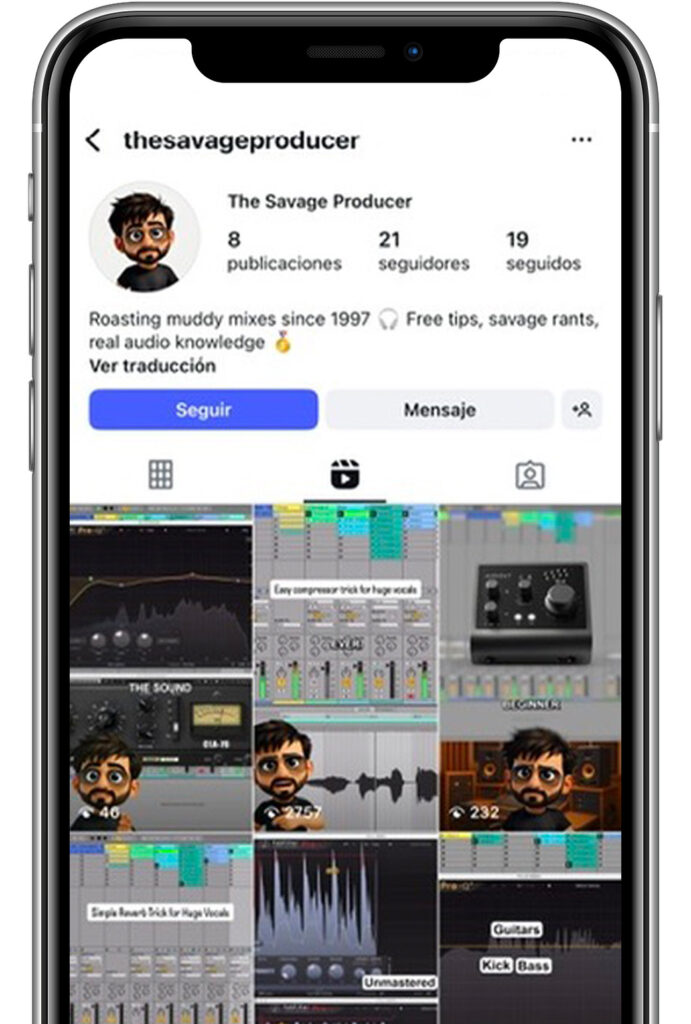What is a bar? What is the time signature?
In music, a bar or measure is a basic unit for organizing and dividing musical time sections. A measure is usually defined by a regular rhythm of beats, called counts. A measure is always delimited in a score by a bar line.
The time signature of a piece of music determines how exactly a bar is divided, i.e. how many beats there are per bar and how long the individual beats are. Example: The time signature 2/4 means that each bar consists of two beats, each of which is a quarter note long.

Time signatures
The time signature in a piece of music is often represented by a fraction, where two numbers are placed on top of each other. This indicates the rhythmic framework of the piece. Each number has its own meaning:
- Upper number (counter): This number indicates how many beats there are in the bar. It shows how many times the specified note value (determined by the subnumber) occurs in the bar. For example, if the upper number is 3 (as in 3/4), then there are three beats in the bar.
- Undernumber (denominator): This number indicates the note value that is counted as a single beat. The sub-number is always a power of 2 and refers to the corresponding note (1 stands for a whole note, 2 for a half note, 4 for a quarter note, 8 for an eighth note, 16 for a sixteenth note...).
As an example:
- 4/4 time: This means that there are four beats in a bar, each beat being a quarter note. This time signature is often referred to as common time.
- 3/4 time: This means that there are three beats in a measure, and that each beat is a quarter note. A waltz is a typical example of a 3/4 time signature.
- 6/8 time: A bar consists of six beats, each beat being an eighth note. Often this bar is divided into two main beats, each consisting of three eighth notes.
Each beat in the bar has its own accentuation order, which describes how strongly or weakly a beat is accentuated within a bar. The basic rule is that the first beat in each bar is strongly accented, and all subsequent beats are less strongly accented.

Simple time signatures
Simple time signatures have either a 2 or a 3 in the numerator (upper fraction). Common examples of this type are 2/4, 3/4, or 3/8. They are called "simple" because in such time signatures there is always only one strongly accented beat in the bar, all others are weak.
- In time signatures with a 2 in the numerator, the first beat is heavily accented, the second slightly accented: heavy - light
- In time signatures with a 3 in the numerator, the first beat is heavily accented, the other two are lightly accented: heavy - light - light
Compound time signatures
Compound time signatures are composed of several simple time signatures. The accent distribution is not always clear from the time signature. However, there is a consensus on the most common time signatures:
For even time signatures (consisting of multiples of 2 in the numerator and denominator), the first beat is heavy, the next weak, the next semi-heavy, the next weak. Example: In 4/4 time, the stress distribution is heavy - weak - semi-heavy - weak.
For odd time signatures (consisting of multiples of 3 in the numerator), the first beat is heavy, the next two are weak, the next is heavy, the next two are weak, and so on. Example: In 6/8 time, the stress distribution is heavy - light - light - (semi)heavy - light - light.
How to choose the right time signature
When you compose a new song, you need to decide what time signature it will have. In most cases it will be 4/4, or another time signature will be given by the style (for example, the time signature for a waltz is always 3/4). Otherwise, you can determine the time signature based on the following factors:
- Feeling and rhythm:
- Listen to the natural rhythm of your melody or song. Clap or tap your foot to feel the basic rhythmic pattern.
- Consider whether the rhythm flows in regular pulses (which might indicate a simple time signature) or whether it moves in groups of three (which might indicate a compound time signature).
- Number of beats:
- Count the number of beats in a repeating pattern or section. This can give you an idea of how many beats per measure make the most sense.
- Musical phrasing:
- Consider how the musical phrases are arranged. A phrase that flows in even steps of 4 is likely to fit well into a 4/4 time signature, while one that flows in groups of 3 might fit into a 3/4 or 6/8 time signature.
- Personal preference:
- Ultimately, there are no hard rules about which time signature is "right" or "wrong. It all depends on your artistic vision and what you are trying to express. If a certain time signature feels right to you, then it is probably the right choice for your song.
Time signatures of different music styles
Although there are no strict rules, there are some time signatures that are more common in certain styles of music:
- Classical music:
- 4/4: Found in many symphonies, sonatas and chamber music pieces.
- 3/4: Waltzes (e.g. the works of Johann Strauss) and other dances.
- 2/4: Polkas and some marches.
- 6/8: Sometimes in faster dances or certain movements of symphonies and suites.
- Jazz:
- 4/4: Most jazz standards, especially in bebop and modern jazz.
- 3/4 and 6/8: Occasionally in more modern forms or in ethno-jazz pieces.
- 5/4 and 7/4: Occasionally in modern jazz or fusion; a well-known example is "Take Five" by Dave Brubeck in 5/4.
- Rock and Pop:
- 4/4: The vast majority of rock and pop music is written in 4/4 time.
- 3/4 and 6/8: Happens less often, but some ballads or more special songs can be in these bars.
- Folk and world music:
- Time signatures can vary according to culture and region. For example, some traditional Bulgarian music uses 7/8 or 11/8, while an Irish jig is typically in 6/8 time.
- Latin music:
- 4/4: Many styles like salsa, cha-cha-cha and bolero.
- 6/8: Some Afro-Cuban rhythms and other traditional forms.
- Country:
- 4/4: The majority of country songs.
- 3/4: Some country ballads or waltzes.
- Blues:
- 4/4: Standard for most blues forms.
- 12/8: A "triplet" 4/4 time often found in slower blues pieces, creating a triplet feel on each beat.
- Electronic Dance Music (EDM):
- 4/4: The dominant time signature for most subgenres of EDM.
The anacrusis
An anacrusis, also called a "pickup," refers to the notes or tones that precede a full bar. It introduces the first full bar of a piece of music or musical phrase.
It results in the first bar of a piece of music not having the full number of beats indicated in the time signature. The anacrusis and the last bar of a piece of music very add up to a full bar together - the last bar is therefore shortened by the length of the anacrusis.

















